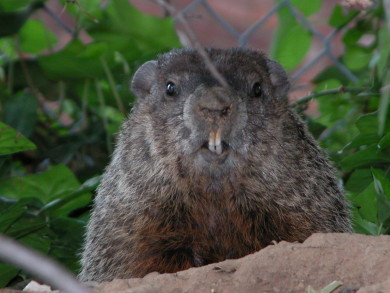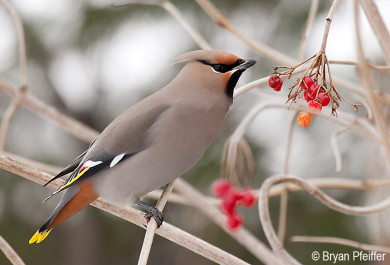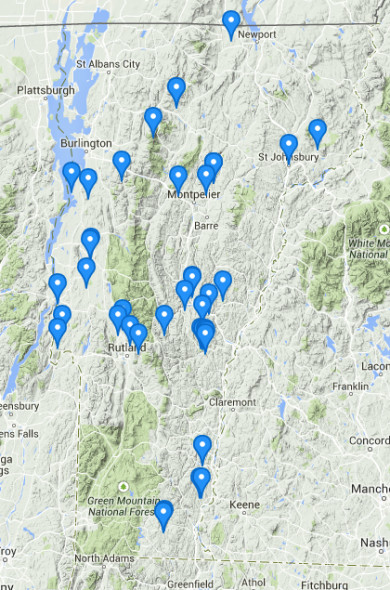
On February 5, wildlife and the rest of us here in New England crossed a threshold – arbitrary yet not insignificant: 10 hours of daylight. You can sense it when you head out in the morning: Black-capped Chickadees, Northern Cardinals and European Starlings are among birds breaking out into song. Even though we’ve got lots more winter, we’ve also got change. So here’s a Field Guide to February.

Groundhog (Marmota monax) / Dave Fletcher – www.flickr.com/photos/dfletcher/
Shadows and Sex
You didn’t need Punxsutawney Phil to know which way the wind blew on February 2. Groundhog Day isn’t about shadows. It’s about romance.
Birds and rodents are beginning a season of foreplay. February 2 is indeed significant. It falls about halfway between the Winter Solstice and the Spring Equinox, a period celebrated in various ways in human traditions from Paganism to Christianity. It seems also to be something of a turning point for wildlife, much of which has to do with the light: there’s more of it. VCE Research Associate Bryan Pfeiffer explains on his blog.

Bohemian Waxwing / © Bryan Pfeiffer
“Hot Seens”
Some of the notable birds seen around Vermont during the past few weeks: Bohemian Waxwings (view eBird map) have begun to join Cedar Waxwings feeding on wild fruit and ornamental trees, even in our cities. We’re also seeing more Common Redpolls (view eBird map) and Pine Siskins (view eBird map) coming to feeders around the state.
Snowy Owls continue to be seen around the Northeast and Midwest; here in Vermont, the Champlain Lowlands, particularly the town of Addison, seems to be the most reliable spot for Snowy Owls (view eBird map of sightings this month).
Check out the eBird bar chart for this month to find out what might be around you.
The First Migrants
Pick your favorite sign of spring: squirrels mating, mud oozing, maples flowering. We like a vulture soaring. Although it’s hardly a long-distance migrant, Turkey Vulture is among the first northbound birds we see (view live eBird map) in northern New England each February. Not far behind are Red-winged Blackbirds (view live eBird map). We hope you’ll add your sightings to eBird.

Locations of coyote observations reported to iNaturalist Vermont, a project of the Vermont Atlas of Life. You can add your wildlife sightings to iNaturalist Vermont.
The Howl of Winter
Eastern coyote breeding season peaks now – around the middle of February. The howl of coyotes can usually be heard on winter nights, especially during mating season. They usually begin breeding at two years of age and may mate for life. The gestation period is approximately nine weeks, with an average litter of six pups.
The Eastern coyote is an opportunistic omnivore. It is both a predator and a scavenger, with a widely varied diet. They’ll eat small rodents, plants, fruit, deer, snowshoe hare, cottontail rabbits, insects, birds and even a woodchuck. At certain times of the year, deer meat can be significant portion their diet.
Although a coyote may kill a fawn or deer in deep snow, it will also readily eat the carcass of a dead deer and other dead animals. Research has shown that although the coyote does prey on deer fawns in the spring and deer in the winter, it is not a major controlling factor on deer numbers with the possible exception of areas where deer populations are already low or winters are extremely severe.

On June 6, 2014, we awoke to find the hindquarters of a fawn partially buried on our front lawn where my husband had spread topsoil to fill a depression. It was fairly close to Route 100. The body looked surgically severed from the front part. There was no blood or mess, just this tiny baby deer 1/2 carcass completely formed. I guess this was done by a coyote. I have several pictures.
Hi Joy,
It was not likely a coyote. They don’t typically cache food like that and they are not so neat. That is either more likely behavior of a cat species or large muselid like a Fisher. We’d love to have this and all your nature sightings in our database at iNaturalist Vermont. Check it out at http://www.inaturalist.org/projects/vermont-atlas-of-life. Thanks for sharing! Kent